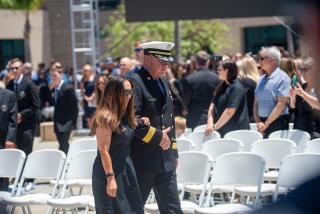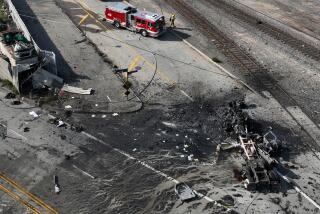11 first responders among the dead in Texas fertilizer explosion
- Share via
WEST, Texas -- Officials confirmed Thursday that 11 first responders were among the dead in a massive explosion at a fertilizer plant that injured at least 160 and devastated a section of this small town.
State public safety officials have declined to specify how many people were killed in the explosion.
Tom Muska, mayor of West, said early in the day that he feared the death toll could be as high as 35 to 40, “because they are unaccounted for and still missing.”
Later in the evening Muska revised his estimate to about 14 after crews had searched 80% of the damaged homes and 75% of the apartments.
“It’s still hard to tell. It’s going to be a much lower number than previously guessed,” he said. “We tried to find out where everyone is, but it’s hard with the chaos.”
The State Firemen’s and Fire Marshals’ Assn. of Texas released a statement late Thursday afternoon saying that six firefighters were killed, as were four emergency medical services workers and another first responder whose affiliation has not been determined.
Among those mourning the loss of firefighters was Bryce Reed, 31, the incident commander at West Emergency Medical Services.
Reed said he and a close friend and fellow firefighter were among the first to respond to the fire at the plant that preceded the explosion. He said he was soon ordered to another position, while his friend stayed behind.
“A bomb went off in all of our lives,” Reed said. “How do you recover from something like this?”
Survivors of the fertilizer plant explosion painted a graphic portrait of the sudden violence Wednesday night, as a stockpile of fertilizing chemicals erupted in a fiery blast the size of a small earthquake.
“In an instant, families have been ripped apart,” Texas Atty. Gen. Greg Abbott said. “But these are tough Texans, and … in the coming months and years these Texans will piece their lives back together.”
The explosion occurred just after 8 p.m. Wednesday and flattened about one-fifth or more of the small town of 2,800 residents. As agents with the federal Bureau of Alcohol, Tobacco, Firearms and Explosives combed the scene for clues into the cause of the blast, search-and-rescue crews used sniffer dogs in a painstaking hunt for survivors.
Rescue efforts were complicated by the need to shore up structures that could collapse on rescuers or the injured. The presence of ammonium nitrate at the devastated West Fertilizer Co. facility -- which may have ignited the blast -- posed a risk to investigators.
“The area where the incident occurred is highly populated, it is a neighborhood, it is devastated, it is still a very volatile situation,” said Matt Cawthon, chief deputy of the McLennan County Sheriff’s Department.
The explosion rocked the earth and then plunged much of the town into darkness, residents said. Many rushed to the blast site, which is near a middle school, a nursing home and an apartment complex.
Mimi Montgomery Irwin, 68, was watching television when she heard a noise like “a supersonic boom in my backyard.” She was immediately knocked to the ground and her TV went dark. When she went outside she saw a mushroom cloud blooming against a yellow-pink sky.
“It was truly surreal,” Montgomery Irwin said.
West residents were quick to pitch in. Muska, the mayor, said many lined up to donate blood and helped evacuate elderly residents at the West Rest Haven senior living center.
Businesses and churches opened their doors to people displaced by explosion, but most beds have stayed empty—a testament to the generosity of a tight-knit community. Many evacuees found lodging with friends or family members, shelter operators said.
“Many of the West people are family-oriented and depend on one another,” said Bev Marrow, the secretary at Church of the Open Door in nearby Bellmead. “It’s a tiny town, but it stretches out pretty far because everybody knows everybody.”
Authorities say they have yet to determine the cause of the blast. Chemists say the explosion could have been caused by either of two chemicals that are commonly used for fertilizer -- ammonia gas or the more well-known explosive, ammonium nitrate.
Neal Langerman, principal chemist with Advanced Chemical Safety, a San Diego industrial consulting firm, said the initial fire could easily have caused anhydrous ammonia gas to explode catastrophically.
“It’s really hard to ignite, but it’s a flammable gas,” Langerman said. “If a tank containing a liquefied flammable gas is subjected to fire, that tank could fail catastrophically, releasing the gas, which will instantly ignite, causing a catastrophic explosion, as was seen.”
A robust fire also would be needed to ignite ammonium nitrate, a well-known explosive used in industry and adopted by terrorists.
The chemical can explode at about 200-250 degrees Fahrenheit, according to Ron Smaldone, an organic chemist at the University of Texas, Dallas.
“Once the reaction starts, it’s really pretty much unstoppable. It’s like dynamite. You can’t put it out with a fire extinguisher,” he said.
West Fertilizer Co. was fined $2,300 in August 2006 by the U.S. Environmental Protection Agency for not having a risk program in place, according to records.
The plant, which was primarily used to store fertilizer, was also investigated in 2006 by the Texas Commission on Environmental Quality for a “very bad” smell, state records show. That complaint was filed in June 2006, and it is unclear from documents what regulatory actions were taken.
The town of West sits amid the wide-open prairie of central Texas. Its downtown is lined with several small Czech restaurants and bakeries, selling sausages and kolaches, a Czech breakfast pastry that has become something of a regional delicacy. The sign out front of the West Chamber of Commerce advertises the upcoming “over 40 dance” and offers birthday wishes to 9-year-old Breanna and to Father Ed.
But even in the areas of town untouched by the blast, the disaster is evident: Streets with modest, older wood-framed houses and big yards are blocked off by law enforcement. Television trucks throughout town have their satellites hoisted, and insurance companies have set up mobile offices in trucks downtown.
A sign in front of St. Mary’s School states simply: “Have faith.”
More to Read
Sign up for Essential California
The most important California stories and recommendations in your inbox every morning.
You may occasionally receive promotional content from the Los Angeles Times.












